Age estimation of domestic animals is very important for farmers during purchasing a new animal since the information provided by the seller may not always be reliable. It is very helpful for field practitioners/clinician for diagnosis and treatment purpose. Age estimation enables the farm manager to take up appropriate managemental practices suitable for different age groups. A researcher/scientist work on different animals should also know exact age of their target groups. Age estimation is also important for collecting statistical data of livestock population age wise, which can be helpful for government policy makers.
There are different methods of Age estimation of domestic animals:
- Teeth method
- Horn method
- Tail brush method
- Other methods
Teeth method
Most widely or reliable method of age estimation is teeth detection. It is a requirement in some locations that prime animals have a dentition indication mark on them prior to auction. This is normally done by the vendor, or the stock agent. Thus two tooth cattle are marked on the wither, four tooth on the middle of the back and six tooth on their high bone (near tail). Milk and eight tooth cattle are not marked. The reliability of attempting to tell the age of cattle by their teeth, as rate of wear can be affected by the forage that is grazed. Drought or grazing on sandy country will also affect rate of wear.
All domestic animals have two successive sets of teeth viz; Deciduous teeth, or milk teeth, are the first set of teeth in young animals and Permanent teeth in adult animals. Anatomically permanent teeth are represented as incisor (I), canine (C), premolar (P), and molar (M); deciduous teeth are designated as Di, Dc, and Dp. In ruminants upper incisors are absent. Instead of that, a hard dental pad present. The dental formulas are shown below. Each formula represents the number of teeth an animal has on one side of its upper and lower jaws; the number is multiplied by two for the total number of teeth in the mouth.
In Ruminants: Dental formula
Deciduous Teeth
Dental Formula: 2(Di 0/3; Dc 0/1; Dp 3/3) = 20
Permanent Teeth
Dental Formula: 2(I0/3; C0/1; P3/3; M3/3) = 32
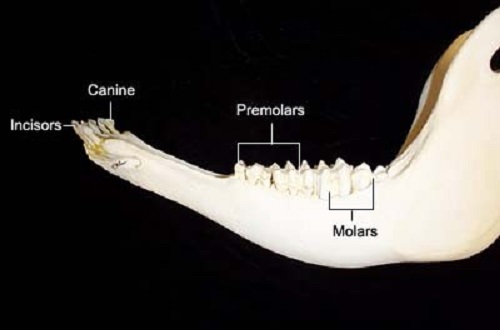
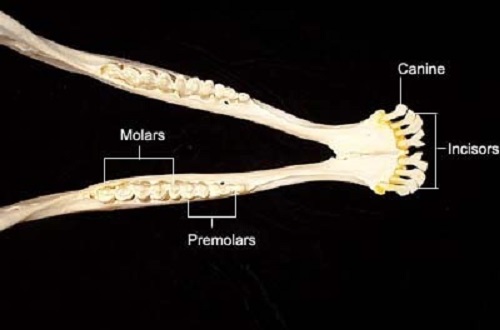
Determining the age of an animal can be identifying by looking at the front teeth. The deciduous incisors teeth are much smaller than the permanent incisors. The crown (that part of the tooth that is covered with enamel) of the deciduous incisors are more narrow than the permanent incisors and they diverge more from the base (at the gum line) of the tooth to the apex when compared to the permanent incisors.
We can easily determine the age of an animal up to four years by looking for permanent teeth on the lower jaw. Cattle are placed in a cattle crush in order to restrain them prior inspecting the mouth and amount of teeth that each animal has. Cattle have thirty-two teeth, including six incisors or biting teeth and two canines in the front on the bottom jaw. The canine teeth are not pointed but look like incisors. Cattle have six premolars and six molars on both top and bottom jaws for a total of twenty-four molars.
Cattle develop eight temporary incisors that are later replaced with eight permanent incisors. The central pair is called the pinchers. Immediately next to the pinchers, the second pair of incisors to develop is referred to as the first intermediates or laterals. The third pair of incisors is also known as intermediates or laterals. They develop next to the previous pair of intermediate incisors. The final pair of incisors develops to the outer sides of the previously erupted incisors. This fourth pair of incisors is called the corners. Among the temporary teeth, there are twelve premolars, three on each side of the upper and three on each side of the lower jaws. Similarly, mature cattle have twelve permanent premolars. There are no temporary molars, only permanent molars. As with the permanent premolars, cattle develop twelve permanent molars. Three permanent molars appear on each side of the upper, and another three molars appear on each side of the lower jaws. With the help of teeth eruption details (given in below table) we can easily asses the age of different domestic animals.
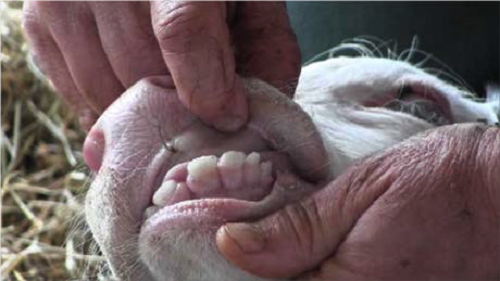
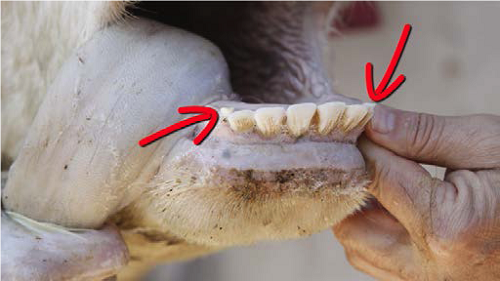
Age of different domestic animals be calculated by time of eruption of different teeth at various stages of age as shown in following table.
Table: Eruption of teeth in different domestic animals
| Tooth | Cattle | Sheep/Goat | Horse | Pig | Dog |
| Di1 | 0–2 wk | 0–1 wk | 0–1 wk | 3–4 wk | 4–5 wk |
| Di2 | 0–2 wk | 1–2 wk | 4–6 wk | 2–3 mo | 4–5 wk |
| Di3 | 0–2 wk | 2–3 wk | 6–9 mo | Before birth | 3–4 wk |
| I1 | 11/2 – 2 yr | 1–1½ yr | 2½ yr | 12–15 mo | 4-5 mo |
| I2 | 2 -2½ yr | 1½–2 yr | 3½ yr | 16–20 mo | 4-5 mo |
| I3 | 3yr | 2–2½ yr | 4½ yr | 8–10 mo | 4-5 mo |
| Dc | 0–2 wk | 3–4 wk | Does not erupt | Before birth | 3–4 wk |
| C | 3½–4 yr | 2½–4 yr | 4–5 yr | 9–10 mo | 4–5mo |
| Dp2(deciduous first cheek tooth) | 0–3 wk | 0–4 wk | 0–2 wk | 4–6 wk | 4–6 wk |
| Dp3 | 0–3 wk | 0–4 wk | 0–2 wk | 1½ mo | 4–6 wk |
| Dp4 | 0–3 wk | 0–4 wk | 0–2 wk | 1–5 wk | 4–6 wk |
| P1 | — | — | 5–6 mo (wolf tooth) | 5 mo | 4–5 mo |
| P2(Permanent first cheek tooth) | 2–2½ yr | 1½–2 yr | 2½ yr | 12–15 mo | 5–6 mo |
| P3 | 1½-21/2 yr | 1½–2 yr | 3 yr | 12–15 mo | 5–6 mo |
| P4 | 2½–3 yr | 1½–2 yr | 4 yr | 12–15 mo | 5–6 mo |
| M1 | 5–6 mo | 3–6 mod | 9–12 mo | 4–6 mo | 4–5 mo |
| M2 | 1–1½ yr | 9–12 mo | 2 yr | 8–12 mo | 5–6 mo |
| M3 | 2–2½ yr | 1½–2 yr | 3 ½ –4 yr | 18–20 mo | 6–7 mo |
Di-deciduous incisor, I-incisor (Permanent), Dp- deciduous premolar, P-permanent premolar, M–Permanent molar, wk-weak, mo-month, yr-year,
Horn method
In cattle at ten or twelve months of age the first ring appears; at twenty months to two years the second; at thirty to thirty-two months the third ring, at forty to forty-six months the fourth ring, at fifty four to sixty months the fifth ring, and so on. But, at the fifth year, the three first rings are indistinguishable, and at the eighth year all the rings. The rings on the horns are less useful as guide.
Tail brush method
The method is useful only when assessing small, stunted or young cattle, when the tail brush is reach about fetlock length or longer is an indication that the cattle is twelve months old or older. This method cannot be used on cattle which have been bang-tailed. Bang tailing is the act of cutting the long hairs at the tip of the tail short to act as a simple identifier of animals.
Other methods
Cattle age in a carcass is determined by checking the physiological skeletal maturity (ossification) (red) of the tips or “buttons” of the thoracic vertebrae. The size and shape of the rib bones are important considerations as well as the colour and texture of the flesh.
Few other methods as number (year) branding, tattoos or ear tags with numbers or different colours are good methods of identifying the age of cattle, if they are used according to standards.
References
- Nutrition and Feeding of the Cow Archived 27 July 2008 at the Wayback Machine Retrieved on 26-3-2009.
- Cole V.G. (1978). Beef Production Guide. Macarthur Press, Parramatta. ISBN 978-0-86840-025-9.
- Household Cyclopedia of General Information, 1881
- Live beef cattle assessment. 1976. Retrieved 31 August 2019.
- https://www.dairyknowledge.in
- National Dairy Development Board (NDDB)
- www.msdvetmanual.com
- Food Safety Inspection Service. 2013. Using dentition to age cattle. U.S. Department of Agriculture, Washington, D.C. Accessed online at http://www.fsis.usda.gov on May 1, 2013.
- National Animal Health Monitoring System. 2010. Beef 2007-09. Part IV: Reference of beef cow-calf management practices in the United States, 2007-08. U.S. Department of Agriculture, Washington,D.C.
- Pace, J. E., and D. L. Wakeman. 2003. Determining the age of cattle by their teeth. CIR253. Florida Cooperative
- Extension Service, Institute of Food and Agricultural Sciences. University of Florida, Gainesville,FL.
- Thrift, F. A., and T. A. Thrift. 2003. Review: Longevity attributes of Bos indicus x Bos taurus crossbred cows. Prof. Anim. Sci. 19:329-341.
- 13.Torrell, R. 1998. Methods of determining age in cattle. Cattle Producer’s Library: CL712. University of Nevada, Reno, NV.
- Troxel, T. R., M. S. Gadberry, S. Cline, J. Foley, G. Ford, D. Urell, and R. Wiedower.
- Factors affecting the selling price of replacement and market cows sold at Arkansas livestock auctions. Prof. Anim. Sci. 18:380-386.
- U.S. Department of Agriculture. 1898. Determination of age by teeth in domesticanimals. In: Yearbook of the United States Department of Agriculture: 1898. Page 667. Washington, D.C.



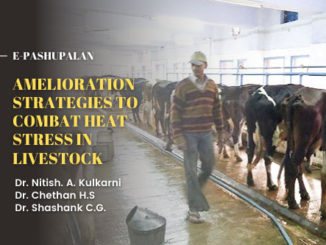
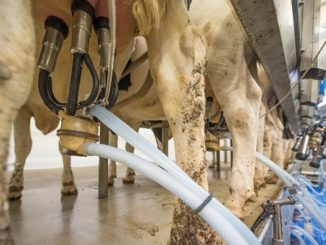

Be the first to comment